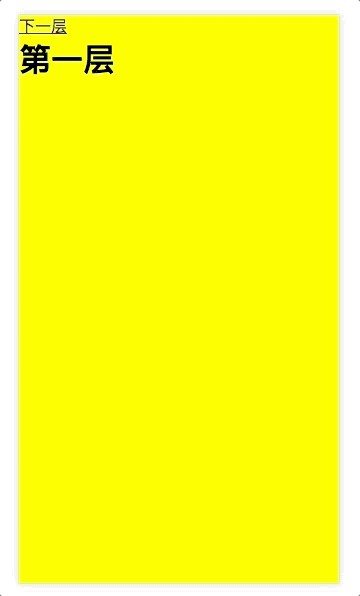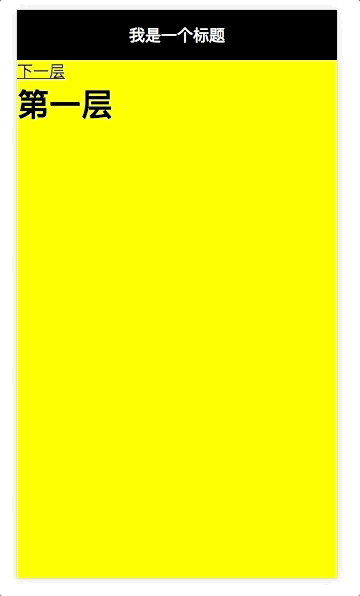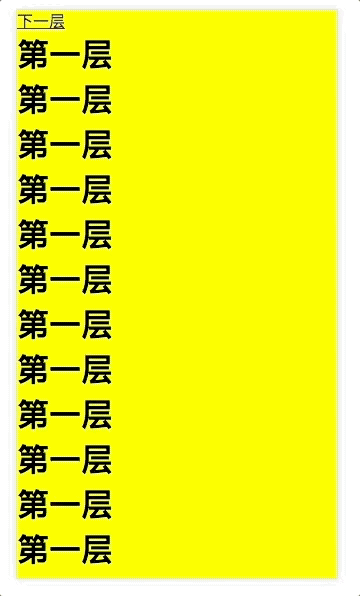Vue如何实现移动端页面切换效果-创新互联
这篇文章给大家分享的是有关Vue如何实现移动端页面切换效果的内容。小编觉得挺实用的,因此分享给大家做个参考,一起跟随小编过来看看吧。

为什么要使用Vue
Vue是一款友好的、多用途且高性能的JavaScript框架,使用vue可以创建可维护性和可测试性更强的代码库,Vue允许可以将一个网页分割成可复用的组件,每个组件都包含属于自己的HTML、CSS、JavaScript,以用来渲染网页中相应的地方,所以越来越多的前端开发者使用vue。
在子页面把整个页面做绝对定位,覆盖整个屏幕,子父页面将 router-view 用 transition 套起来,并加上过渡动画就可以啦。
代码:
<!DOCTYPE html>
<html lang="en">
<head>
<meta charset="UTF-8">
<meta name="viewport" content="width=device-width, initial-scale=1.0, maximum-scale=1.0, minimum-scale=1.0, user-scalable=no">
<title>Document</title>
<style>
* { padding: 0; margin: 0; }
html, body, #app { width: 100%; height: 100%; }
.one { height: 100%; background-color: yellow; }
.two { background-color: tomato; position: fixed; top: 0; bottom: 0; left: 0; right: 0; }
.three { background-color: #ffe69f; position: fixed; top: 0; bottom: 0; left: 0; right: 0; }
.v-enter-active, .v-leave-active { transition: all 0.3s; }
.v-enter, .v-leave-to { transform: translateX(100%); }
</style>
</head>
<body>
<div id="app">
<div class="one">
<p>
<router-link to="/foo">下一层</router-link>
</p>
<h2>第一层</h2>
</div>
<transition>
<router-view></router-view>
</transition>
</div>
<script src="https://unpkg.com/vue/dist/vue.js"></script>
<script src="https://unpkg.com/vue-router/dist/vue-router.js"></script>
<script>
const Foo = {
template: `
<div class="whole-page two">
<router-link to="/foo/bar">下一层</router-link>
<router-link to="/">返回</router-link>
<h2>第二层</h2>
<transition>
<router-view></router-view>
</transition>
</div>
`
}
const Bar = {
template: `
<div class="whole-page three">
<router-link to="/foo">返回</router-link>
<h2>第三层</h2>
<transition>
<router-view></router-view>
</transition>
</div>
`
}
const routes = [
{ path: '/foo', component: Foo, children: [ { path: 'bar', component: Bar } ] }
]
const router = new VueRouter({ routes })
const app = new Vue({ router }).$mount('#app')
</script>
</body>
</html>效果:

有一个问题需要注意一下,
我们知道,在应用transform属性的时候,fixed定位会变成absolute。
这里,页面转换的时候,就变成了相对translation定位。所以如果子页面中有绝对定位的话,移动的过程中页面会变形。
简单举个栗子,
<!DOCTYPE html>
<html lang="en">
<head>
<meta charset="UTF-8">
<meta name="viewport" content="width=device-width, initial-scale=1.0, maximum-scale=1.0, minimum-scale=1.0, user-scalable=no">
<title>Document</title>
<style>
* { padding: 0; margin: 0; }
html, body, #app { width: 100%; height: 100%; }
#app { padding-top: 50px; }
.one { height: 100%; background-color: yellow;}
.two { background-color: tomato; position: fixed; top: 100px; bottom: 0; left: 0; right: 0; }.v-enter-active, .v-leave-active { transition: all 0.3s; }
.v-enter, .v-leave-to { transform: translateX(100%); }
header { height: 50px; background-color: #000; width: 100%; position: fixed; top: 0; color: #fff; line-height: 50px; text-align: center; }
.two header { top: 50px; background-color: #666; }
</style>
</head>
<body>
<div id="app">
<header>我是一个标题</header>
<div class="one">
<p>
<router-link to="/foo">下一层</router-link>
</p>
<h2>第一层</h2>
<transition>
<router-view></router-view>
</transition>
</div>
</div>
<script src="https://unpkg.com/vue/dist/vue.js"></script>
<script src="https://unpkg.com/vue-router/dist/vue-router.js"></script>
<script>
const Foo = {
template: `
<div class="whole-page two">
<router-link to="/">返回</router-link>
<header>我也是一个标题</header>
<h2>第二层</h2>
<transition>
<router-view></router-view>
</transition>
</div>
`
}
const routes = [
{ path: '/foo', component: Foo }
]
const router = new VueRouter({ routes })
const app = new Vue({ router }).$mount('#app')
</script>
</body>
</html>看下效果:

OKOK,反正就是这种bug嘛。
解决办法就是,就是,尽量让页面fixed定位都是0 0 0 0,然后偏移用padding实现。
大概吧……反正我是这么解决的……
比如上面那个可以把CSS改成这样解决问题。
* { padding: 0; margin: 0; }
html, body, #app { width: 100%; height: 100%; }
#app { padding-top: 50px; }
.one { height: 100%; background-color: yellow;}
.two { background-color: tomato; position: fixed; top: 0; padding-top: 100px; bottom: 0; left: 0; right: 0; }.v-enter-active, .v-leave-active { transition: all 0.3s; }
.v-enter, .v-leave-to { transform: translateX(100%); }
header { height: 50px; background-color: #000; width: 100%; position: fixed; top: 0; color: #fff; line-height: 50px; text-align: center; z-index: 100; }
.two header { top: 50px; background-color: #666; }嗯嗯 还有一个问题,还有个滑动穿透的问题
我再举个栗子,
<!DOCTYPE html>
<html lang="en">
<head>
<meta charset="UTF-8">
<meta name="viewport" content="width=device-width, initial-scale=1.0, maximum-scale=1.0, minimum-scale=1.0, user-scalable=no">
<title>Document</title>
<style>
* { padding: 0; margin: 0; }
html, body, #app { width: 100%; height: 100%; }
.one { min-height: 100%; background-color: yellow;}
.two { background-color: tomato; position: fixed; top: 0; bottom: 0; left: 0; right: 0; }
.three { background-color: #ffe69f; position: fixed; top: 50px; bottom: 0; left: 0; right: 0; }
.v-enter-active, .v-leave-active { transition: all 0.3s; }
.v-enter, .v-leave-to { transform: translateX(100%); }
</style>
</head>
<body>
<div id="app">
<div class="one">
<p>
<router-link to="/foo">下一层</router-link>
</p>
<h2>第一层</h2><h2>第一层</h2><h2>第一层</h2><h2>第一层</h2><h2>第一层</h2>
<h2>第一层</h2><h2>第一层</h2><h2>第一层</h2><h2>第一层</h2><h2>第一层</h2>
<h2>第一层</h2><h2>第一层</h2><h2>第一层</h2><h2>第一层</h2><h2>第一层</h2>
<transition>
<router-view></router-view>
</transition>
</div>
</div>
<script src="https://unpkg.com/vue/dist/vue.js"></script>
<script src="https://unpkg.com/vue-router/dist/vue-router.js"></script>
<script>
const Foo = {
template: `
<div class="whole-page two">
<router-link to="/">返回</router-link>
<h2>第二层</h2>
<transition>
<router-view></router-view>
</transition>
</div>
`
}
const routes = [
{ path: '/foo', component: Foo }
]
const router = new VueRouter({ routes })
const app = new Vue({ router }).$mount('#app')
</script>
</body>
</html>看效果,第二页的高度明明就是视窗的高度,但是它有一个滚动条,实际上那是第一个页面的滚动条。
网上找了好多方法,一一试了,全部不生效。(当然很有可能是我的方法不对。

最后没办法只有找最笨的方法啦,就是通过 v-if 把父页面不显示就好了。
当然不能直接不显示,因为动画还没结束父元素就空白了呀!setTimeout 就好了……
感谢各位的阅读!关于“Vue如何实现移动端页面切换效果”这篇文章就分享到这里了,希望以上内容可以对大家有一定的帮助,让大家可以学到更多知识,如果觉得文章不错,可以把它分享出去让更多的人看到吧!
另外有需要云服务器可以了解下创新互联scvps.cn,海内外云服务器15元起步,三天无理由+7*72小时售后在线,公司持有idc许可证,提供“云服务器、裸金属服务器、高防服务器、香港服务器、美国服务器、虚拟主机、免备案服务器”等云主机租用服务以及企业上云的综合解决方案,具有“安全稳定、简单易用、服务可用性高、性价比高”等特点与优势,专为企业上云打造定制,能够满足用户丰富、多元化的应用场景需求。
网页名称:Vue如何实现移动端页面切换效果-创新互联
分享链接:https://www.cdcxhl.com/article36/pihsg.html
成都网站建设公司_创新互联,为您提供关键词优化、品牌网站设计、外贸网站建设、ChatGPT、域名注册、小程序开发
声明:本网站发布的内容(图片、视频和文字)以用户投稿、用户转载内容为主,如果涉及侵权请尽快告知,我们将会在第一时间删除。文章观点不代表本网站立场,如需处理请联系客服。电话:028-86922220;邮箱:631063699@qq.com。内容未经允许不得转载,或转载时需注明来源: 创新互联

- 静态网站与动态网站的区别 2021-04-26
- 静态页面网站打开速度相对性比动态网站快 2016-11-07
- 静态网站与动态网站之间的区别 2022-06-05
- 动态网页和静态网页的区别 2016-08-05
- 网页制作设计趋势是动态的不断变化 2016-09-16
- 公司网站制作有关动态网站的制作方法 2016-08-21
- 网站建设选择动态还是静态页面好 2013-10-08
- 企业网站建设PHP动态网站运行原理 2022-05-01
- 静态网站跟动态网站在制作上有哪些区别呢 2016-11-12
- 成都网站建设公司浅析静态与动态网站的区别 2023-03-04
- 动态参数对SEO有什么影响? 2015-07-07
- 动态网站和静态网站有什么区别 2016-07-11